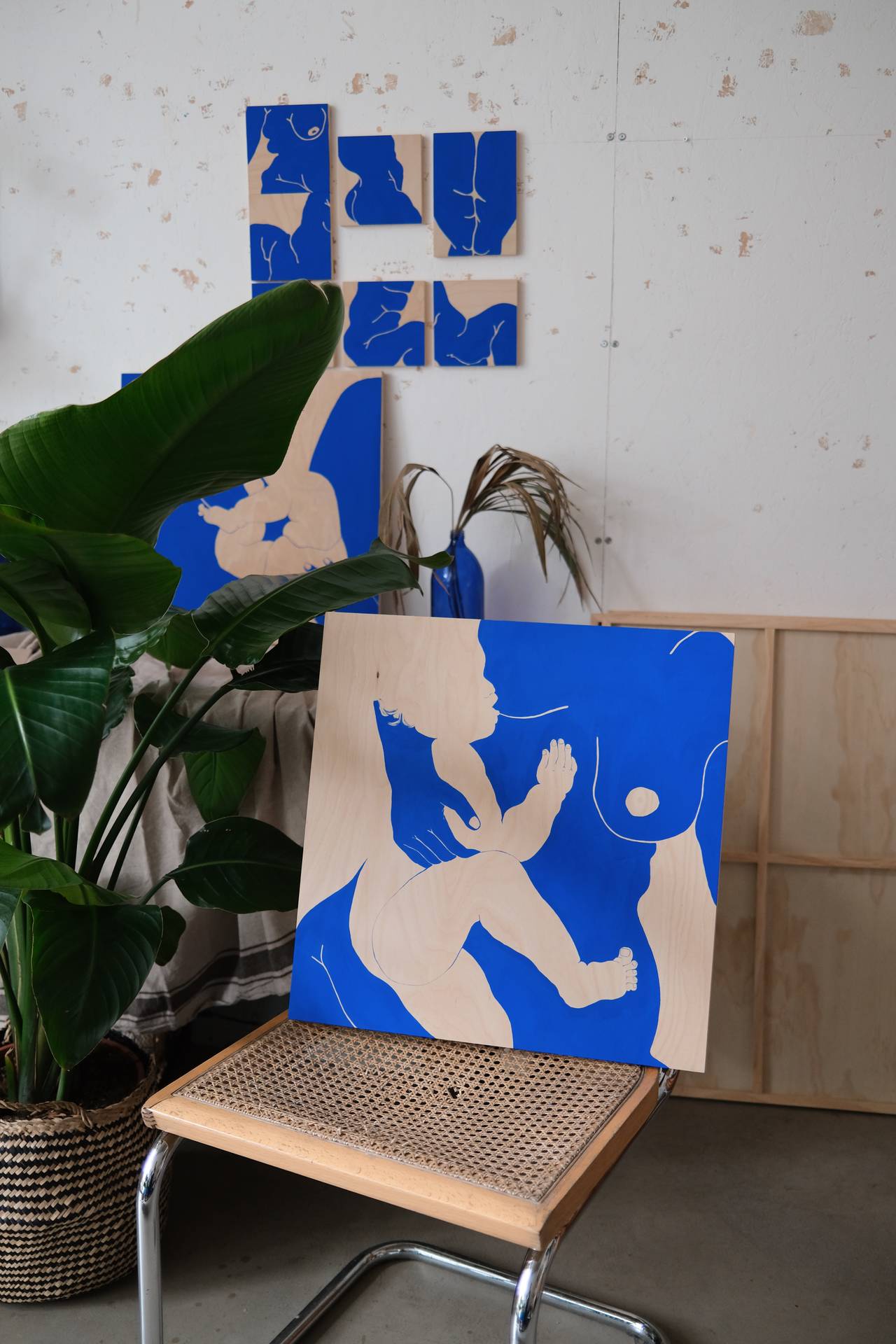In her works, artist Laxmi Hussain explores the special physical closeness of being a parent. At the same time, she calls for a more realistic representation of motherhood in art and society.
Born and raised in London, Laxmi Hussain became a full-time artist when she became a mother. The painter is the fifth and final artist we interviewed as part of our series on motherhood inspired by the retrospective of the works of Paula Modersohn-Becker. Other interviewees include Hannah Cooke, Najja Moore, Lenka Clayton, and Clarity Haynes.
Hussain’s bright blue, free flowing female body paintings exist somewhere between the abstract and the realistic. Although she studied to become an architect, she ultimately decided to be a painter, trying to use her art to reclaim her own identity amid the “emotional blurrings of motherhood.”

Laxmi, could you tell us a bit about your art practice?
Mostly I'm a painter and a lot of my practice includes drawing, I often paint the female body, aspects of it and observe more close-up details a lot. More recently, I have been depicting aspects of motherhood, including elements of my baby in my work seemingly jigsawed into elements of my body. Simply put, I love being a mother, I love the wonderful moments wrapped up being a mother despite how hard and challenging it can often be. In my work I've been exploring that closeness.
Children as puzzle pieces: what a beautiful metaphor for motherhood! How does motherhood as a topic influence your work?
It's everything I do, visually and not. My whole schedule is governed by becoming a mother, from the school runs, to nap times and everything else in between. In my paintings I depict elements of mothering, however I invite you to see that you are often drawn to the baby, the beautifully soft, blissful moments – they appear crisp and clearly the wonderful parts, but the mother is often not so clearly depicted, or perhaps blurred in existence, or an essence. I truly love being a mother, I'm very grateful to have this stage of life and to be able to enjoy it amongst the sometimes exhausting moments. However, I feel a real experience of mothering is often never shared, the elements of juggling a million life things, the experience of how a mothering body changes, the closeness of our bodies to our children, those things are such a normal part of this transition in life, and they should be more normalized.



Paula Modersohn-Becker was one of the first artists that systematically explored the motif of motherhood, painting pregnancy as well as mothers and children at the turn of the twentieth century. Is motherhood – getting pregnant, giving birth, having children – still a taboo topic in the arts today?
I certainly feel that! It is either that, or motherhood is put on a pedestal. There is this blissful idea of motherhood which always needs to be depicted and in some way adhered to. Motherhood is messy, it's trying and exhausting, yet a mother often finds it the most rewarding role they'll ever play. A mother is often left wondering how they appear to achieve so little in a day, when in actual fact we dismiss all the parts of mothering which we just do automatically because those elements aren't often seen in mothering – I feel this is reflective of what we see depicted in art, we don't see the real. We see all the wonderful elements, but not the things which make the journey – which is: real women who happen to be mothers, people who exist beyond motherhood and their real experiences.
Taboo or pedestal, it’s sad that it often comes down to this. Do you have a personal connection to Paula Modersohn-Becker and her work?
On her views on motherhood and art I do indeed connect with Paula Modersohn-Becker, I understand first-hand the challenges a mother faces, wishing to be a mother and the desire to paint, being an artist at the same time. I think there is such a fine balance and women who are career driven can be made to feel that it's not possible to do both, and if they aren't good, attentive mothers that in some ways they are failing. I admire her work for the need to challenge the way we paint ourselves as women, as our bodies adapt to the world around us and we should feel free to depict that and make that visible.

Agreed, Paula Modersohn-Becker was way ahead of her time! Even though she pushed motherhood down the line because she was afraid, she wouldn’t be able to be active as an artist after becoming a mother… What would you like to communicate to your audience with your works on motherhood?
I invite the viewer to see that the body is a vessel, and motherhood can be one such journey in which that vessel adapts and moves through that time. For so much of my life I was viewing only one type of body, and this had an impact on the way I needed my body to be. Bodies respond to so many influences in life that cause it to change shape and to adapt, but we are taught to ignore this and to have this image of one perfect body in mind. I hope that my work allows the viewer to see their own body as a vessel and that change is inevitable and that is absolutely normal.
Normalizing different shapes of bodies is something that we must work on in the future! Last question: When you think of motherhood in the arts who comes to mind, any artists you would like to give a shoutout to or that inspired you?
Definitely Hester Finch, her work in motherhood is just beautiful, as are all her works. There are quite a few photographers who depict motherhood that I am inspired by, the artist I really am drawn to is Lisa Sorgini.









